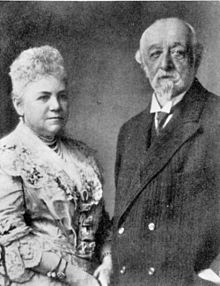Johanna von Schaffgotsch
Johanna von Schaffgotsch (born April 29, 1842 in Poremba , Oberschlesien ; † June 21, 1910 in Koppitz , Oberschlesien) was a German entrepreneur, Silesian nobleman, adopted daughter and sole heir of the industrialist Karl Godulla (1781-1848) and wife of the count and mining industrialist Hans Ulrich von Schaffgotsch .
Life
Johanna von Schaffgotsch, née Gryczik (according to other sources often also in the form of Gryzik ), came from a family of miners. She was born on April 29, 1842 in Poremba in the district of Beuthen as the daughter of the miner Johann Gryzik Julieger and his wife Antonia Hein. After the father's death in 1845, the mother left the child to herself. In 1846, Karl Godulla took care of the girl, moved with her to the Schomberg Castle he had bought and had the child looked after by his servant Emilie Lucas (later married Gemander) . Karl Godulla, who remained without descendants, adopted Gryczik and made his adopted daughter the sole heir to his property when he died from cholera in 1848. Johanna Gryczik inherited a fortune of around two million talers, consisting of four zinc smelters, 18 galmei shafts and 40 coal mines.
In the following years she met Count Hans Ulrich von Schaffgotsch (1831–1915). In order to be able to marry him, she was raised to the nobility in 1858 by the Prussian King Friedrich Wilhelm IV and from then on bore the name Johanna Gryczik von Schomberg-Godulla. In the same year the wedding of the "Silesian Cinderella " took place in the Marienkirche in Beuthen OS . From then on she lived at Koppitz Castle . The couple had four children: Elisabeth, Clara, Hans Karl and Eleonore.
After assuming the inheritance, the company did not pass to her husband, but it was continued as the property of Johanna under the company " Countess Schaffgotsch'sche Verwaltung ". The company owned shares in 60 coal mines and calamine mines (zinc ore mines). On this basis, the couple created the largest zinc production in Germany and expanded coal production. The Schaffgotsch works were one of the four largest mining companies in Silesia around 1900. In 1891 almost five thousand workers were employed in the factories and mines. In the 1890s, she withdrew her capital from the zinc industry through sale or lease. In 1905 their property was transferred to the Gräflich Schaffgottsche Werke mbH with a share capital of 50 million marks. She died on June 21, 1910 in Koppitz and was buried in the mausoleum of the Schaffgotsch family in Koppitz.
Charitable work
Johanna von Schaffgotsch had a special reputation for her benefits. She donated u. a. Hospitals, churches and schools, had new buildings built and maintained the orphanage in Beuthen OS
literature
- Schaffgotsch, Johanna Countess of. In: New German Biography (NDB). Volume 22, Duncker & Humblot, Berlin 2005,ISBN 3-428-11203-2, p. 537 ( digitized version ).
Web links
- Article from the Caritas library in Opole
- Culture portal west-east. Schaffgotsch, Countess Johanna von
Individual evidence
- ↑ Festschrift for the golden wedding celebration at Koppitz Castle
- ^ A b Elisabeth Fehrenbach : Nobility and bourgeoisie in Germany 1770–1848. Munich 1994.
| personal data | |
|---|---|
| SURNAME | Schaffgotsch, Johanna von |
| BRIEF DESCRIPTION | German entrepreneur and noblewoman |
| DATE OF BIRTH | April 29, 1842 |
| PLACE OF BIRTH | Poremba , district of Bytom |
| DATE OF DEATH | June 21, 1910 |
| Place of death | Koppitz , Grottkau district |


